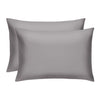The Daily Miracle
How To Sleep On Your Back: 10 Tips & Benefits
Published
September 19, 2024
Author
Miracle Brand

Are you struggling to get a good night's sleep? Have you tried everything from fancy pillows to googling things like, “What direction should your bed face?” without success? It might be time to consider your sleeping position.
Back sleeping, also known as supine sleeping, can offer numerous benefits for your health and sleep quality. In this guide, we'll explore the benefits of sleeping on your back and share practical tips to help you transition to this position.
What Are the Benefits of Sleeping on Your Back?
1. Improved Spinal Alignment
Sleeping on your back helps maintain the natural curve of your spine. This position supports the alignment of your head, neck, and spine, reducing the risk of neck and lower back pain. By keeping your spine in a neutral position, back sleeping minimizes pressure on your joints, making it one of the best sleeping positions for spinal health.
For those with cervicogenic headaches, this alignment can also reduce tension and discomfort. Many back sleepers find that using a memory foam pillow helps maintain proper spinal alignment throughout the night, promoting overall wellness and better sleep quality.
Additionally, a supportive mattress, such as a firm mattress, can enhance these benefits by providing consistent support and maintaining the spine's natural curve.
2. Reduced Pressure on Joints
Back sleeping distributes your body weight evenly, which can alleviate tension in your joints. This is particularly beneficial for individuals with arthritis or other joint-related health conditions. This even distribution of weight can also prevent pressure sores and improve circulation, further enhancing your sleep quality.
For those with lower back pain, placing a pillow under the knees can reduce strain on the lower back and promote a more comfortable sleeping posture. By reducing joint stress and enhancing blood flow, back sleeping contributes to overall wellness and a more restful night’s sleep.
3. Minimized Wrinkles and Skin Benefits
Sleeping on your back can help prevent fine lines, puffiness, and breakouts. Unlike side sleeping or stomach sleeping, which can press your face against the pillowcase and lead to wrinkles, back sleeping keeps your face clear of contact. This reduces friction and allows your skin to breathe, promoting a clearer and healthier complexion.
By keeping your face off the pillowcase, you also minimize the transfer of dirt and oil, which can clog pores and cause breakouts. For those prone to skin irritation, back sleeping can be a game-changer. Additionally, this position helps reduce morning puffiness, as it promotes better lymphatic drainage and prevents fluid from pooling around the face.
5. Alleviates Sinus and Nasal Congestion
If you suffer from sinus buildup or nasal congestion, sleeping on your back can help. This position keeps your airway open, reducing the likelihood of sinus blockages.
It can also benefit those with sleep apnea or other sleep disorders by minimizing airway obstruction. Elevating your head slightly with wedge pillows can further enhance this benefit by preventing mucus from pooling in your sinuses and helping you breathe more easily.
If you have conditions like obstructive sleep apnea, back sleeping can reduce episodes of interrupted breathing, leading to a more restful night’s sleep. By keeping the airway open and reducing congestion, back sleeping supports overall respiratory health and can significantly improve your sleep quality.
What Are the Best Tips for Sleeping on Your Back?
6. Use a Supportive Pillow
Finding the right pillow is crucial for back sleepers. Ensure your pillow isn't too high or too low to keep your neck in a neutral position. The right pillow will support your head without tilting it too far forward or backward, which helps to prevent neck pain and tension headaches.
It’s also important to make sure your bedding supports you, too. Our Miracle Made® Pillowcases can help take your pillow to the next level. Infused with silver, these pillowcases maintain the perfect temperature, reducing night sweats and keeping you comfortable.
Designed for clearer skin, they prevent up to 99.7% of bacteria growth, ensuring you stop sleeping on germs that cause acne and morning stuffiness. Enjoy fewer odors and up to 3x less laundry, as Miracle Made® Pillowcases stay fresher for longer.
7. Elevate Your Head Slightly
Using wedge pillows or an adjustable bed can help elevate your head. This elevation can reduce snoring, prevent acid reflux, and improve overall sleep quality. Aim to keep your head at an angle that feels comfortable yet effective in preventing reflux.
Even a slight elevation can make a significant difference in reducing symptoms of GERD and obstructive sleep apnea. Additionally, elevating your head can help alleviate sinus buildup and promote clearer breathing.
8. Keep Your Legs Straight
Maintaining straight legs while you sleep helps in keeping your spine aligned. You can place a pillow under your knees to reduce lower back strain and promote better spinal alignment.
This simple adjustment can significantly alleviate lower back pain. Keeping your legs straight prevents the lower spine from arching unnaturally, which helps reduce pressure on the lower back and promotes a neutral position.
9. Gradually Transition To Back Sleeping
If you're a side sleeper or stomach sleeper, transitioning to back sleeping might take time. Start by lying on your back for short periods during the day or while relaxing. Gradually increase the time you spend on your back each night until it becomes your preferred sleeping position.
You might find it helpful to use pillows strategically to prevent rolling over into your usual sleeping position. For instance, place pillows on either side of your body to create a supportive barrier. This gradual approach can help your body adapt to the new sleeping position without causing discomfort or disrupting your sleep quality.
10. Strengthen Your Core Muscles
A strong core can help maintain a comfortable back-sleeping position. A strong core supports the natural curve of your spine, reducing strain on your lower back and promoting better spinal alignment. Additionally, core exercises can help prevent common issues such as lower back pain and tension headaches, which are often linked to poor sleep posture.
Enhancing your core strength creates a stable foundation for your back sleeping, ensuring you wake up feeling refreshed and free from discomfort. This proactive approach improves your sleep quality and contributes to your overall health and wellness.
The Bottom Line
Switching to back sleeping can bring numerous benefits, from improved spinal alignment to clearer skin and reduced acid reflux. By following these tips, you can make the transition smoother and enjoy a better night's sleep.
So, if you're ready to experience the benefits of back sleeping, start making these changes today. Your body will thank you for it!
Sources:
Antibacterial Silver | National Library of Medicine
Good Sleeping Posture Helps Your Back | University of Rochester Medical Center


























